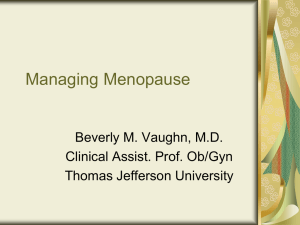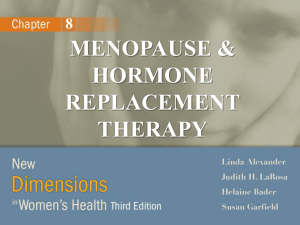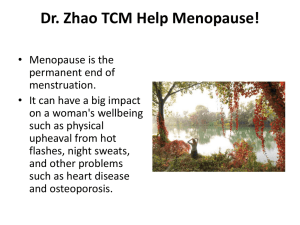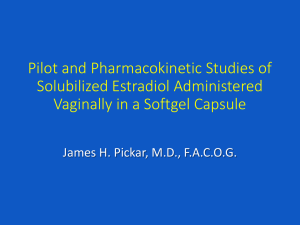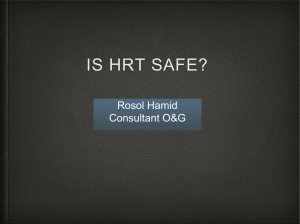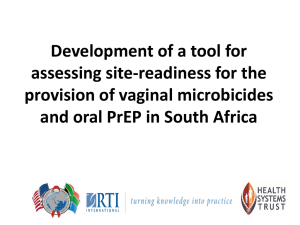Slide Set in English - North American Menopause Society
advertisement
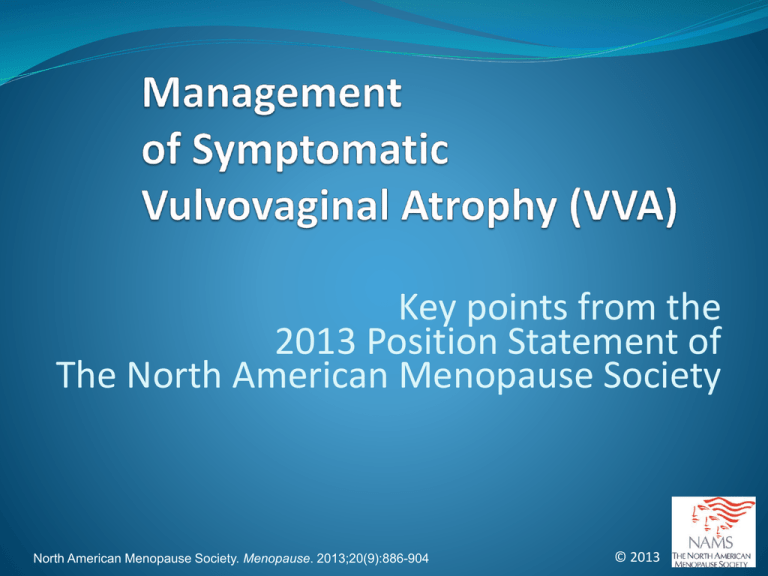
Key points from the 2013 Position Statement of The North American Menopause Society North American Menopause Society. Menopause. 2013;20(9):886-904 © 2013 Therapeutic goals Alleviate symptoms of VVA Preserve sexual function North American Menopause Society. Menopause. 2013;20(9):886-904. © 2013 Nonprescription therapies Vaginal lubricants and moisturizers — Should be considered first-line therapies — Over-the-counter products can significantly decrease or eliminate symptoms for many women Herbal products have not demonstrated any beneficial effect in clinical trials North American Menopause Society. Menopause. 2013;20(9):886-904. © 2013 Prescription therapies Low-dose vaginal estrogen therapy (ET) Ospemifene (indicated for dyspareunia) North American Menopause Society. Menopause. 2013;20(9):886-904. © 2013 Vaginal ET: Types US FDA-approved vaginal ET products — Estradiol vaginal cream (Estrace)a — Conjugated estrogen vaginal cream (Premarin)a — Estradiol vaginal ring (Estring) — Estradiol acetate vaginal ring (Femring)b — Estradiol hemihydrate vaginal tablet (Vagifem) All are effective at recommended doses Choice depends on clinical experience and patient preference aMultiple doses available; use low dose for VVA. bThis product delivers systemic levels of estradiol. North American Menopause Society. Menopause. 2013;20(9):886-904. © 2013 Vaginal ET: Effectiveness Typically provides greater benefit than nonhormonal interventions Preferred mode of delivery when vaginal symptoms are the only complaint Shown in clinical trials to be more effective than systemic oral ET May also reduce risk of urinary urgency and recurrent urinary tract infections North American Menopause Society. Menopause. 2013;20(9):886-904. © 2013 Vaginal ET: Safety Presumed lower risk than commonly used doses of systemic ET Serum estrogen levels reported with use are within postmenopausal range North American Menopause Society. Menopause. 2013;20(9):886-904. © 2013 Vaginal ET: Adverse effects Vulvovaginal candidiasis, uterine bleeding, mastalgia, and nausea have been reported; may be dose-related Data for women at high risk for venous thromboembolism are lacking Endometrial carcinoma is a concern with use of ET in women who have a uterus North American Menopause Society. Menopause. 2013;20(9):886-904. © 2013 Vaginal ET: Length of therapy Improvement in symptoms typically occurs within a few weeks of starting treatment Vaginal ET may be continued as long as distressful symptoms remain North American Menopause Society. Menopause. 2013;20(9):886-904. © 2013 Vaginal ET and endometrial carcinoma Insufficient data to recommend annual endometrial surveillance in asymptomatic women Closer surveillance may be required if a woman is — Using a higher dose of vaginal ET — At high risk for endometrial cancer — Having symptoms such as spotting, breakthrough bleeding North American Menopause Society. Menopause. 2013;20(9):886-904. © 2013 Vaginal ET and breast cancer Symptoms of VVA are common among women with breast cancer, especially those on endocrine treatments or aromatase inhibitors For women with a nonhormone-dependent cancer, VVA management is similar to that for women without cancer For women with a hormone-dependent cancer, VVA management depends on each woman’s preference in consultation with her oncologist North American Menopause Society. Menopause. 2013;20(9):886-904. © 2013 Ospemifene Nonhormonal selective estrogen- receptor modulator (SERM) Only SERM approved in the United States to treat moderate to severe dyspareunia North American Menopause Society. Menopause. 2013;20(9):886-904. © 2013 Ospemifene: Effectiveness Two 12-week studies showed improvements with daily use (60 mg) in — Vaginal maturation index — Vaginal pH — Most bothersome symptom (vaginal dryness) 52-week extension study showed sustained improvements with no cases of venous thromboembolism, endometrial hyperplasia, or carcinoma North American Menopause Society. Menopause. 2013;20(9):886-904. © 2013 Ospemifene: Adverse effects Vasomotor symptoms most common Prescribing information contains precautions similar to those for estrogens and other SERMs Data in women with breast cancer or at high risk of developing breast cancer are lacking North American Menopause Society. Menopause. 2013;20(9):886-904. © 2013
